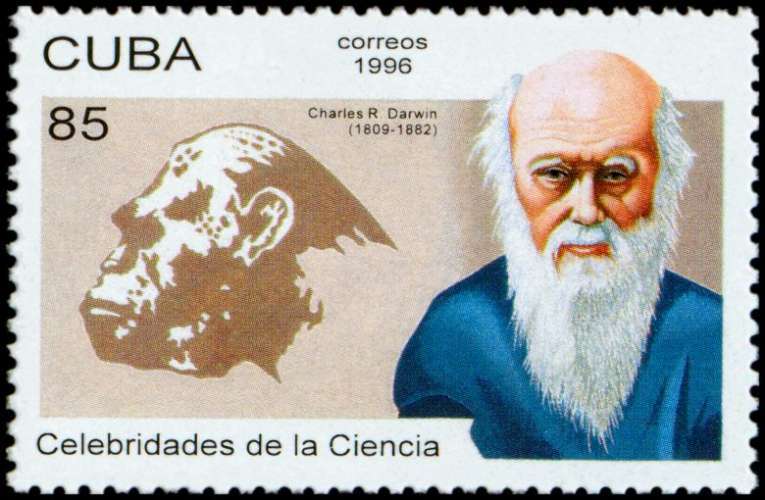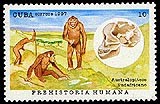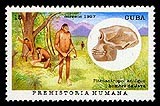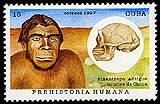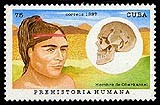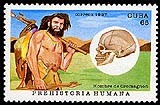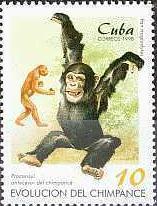
CUBA
1967
Origins of the Man
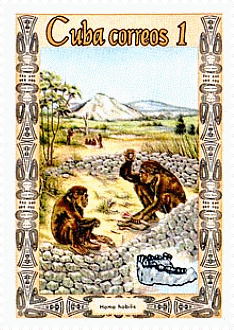
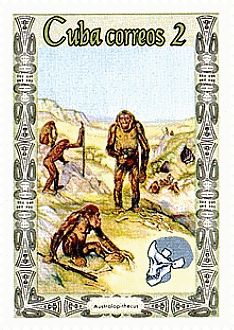
Homo habilis ( left ); Australopithecus ( right )

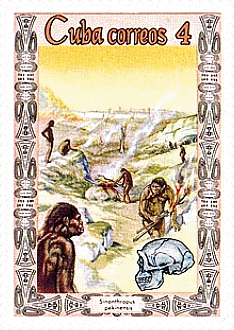
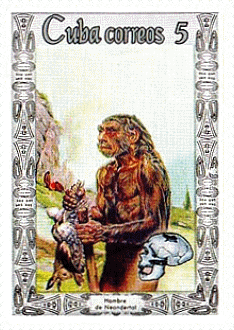
Pithecanthopus erectus (left ); Sinanthropus pekinensis (center ); Homo neanderthalensis (right )
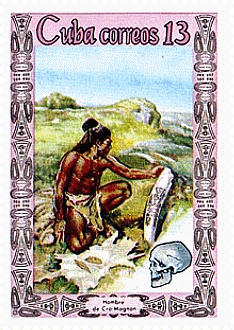

Men of the Cro-Magnon
Origins of the Man
1 c., Homo habilis and jaw,
2 c., Australopithecus and skull,
3 c., Pithecanthropus erectus and skull roof,
4 c., Sinanthropus pekinensis and skull,
5 c., 'Hombre de Neandertal' and skull,
13 c., 'Hombre de Cro Magnon' and skull,
20 c., 'Hombre de Cro Magnon' and skull.
Issue date: 31-th of March.
Scott: 1210-1216.
Stanley Gibbons: 1462-1468.
Yvert nº. 1094/1100
FDC in 31.Mar.1967 - Figurative postmarck
Pithecanthropus erectus and Sinanthropus pekinensis are both Homo
erectus,
Hombre de Neandertal is Homo sapiens neanderthalensis,
Hombre de Cro Magnon is Homo sapiens.
![]()
1989
Homo sapiens sapiens
petrographies of Taina
Yvert nº. 2952/2953
Issue date: 12.10.1989
![]()
1990
Homo sapiens sapiens
Yvert nº. 3007
Issue date: 15.01.1990
![]()
1996
Celebrities of Science
Cherles Robert Darwin
and
Dryopithecus ( Proconsul ) africanus
Yvert nº. 3514 { Set in Yvert nº. 3510/3514 }
![]()
1997
Prehistoric men
Australopithecus (africanus) boisei |
Homo (Pithecanthropus) erectus | Homo sapiens neanderthalensis |
Homo (Sinanthropus) pekinensis |
Homo sapiens fossilis | Homo sapiens oberkassel |
'Prehistoria Humana'.
10 c., Australopiteco Sudafricano' (Australopithecus africanus),
15 c., 'Pitecantropo Antiguo hombre de Java' (Homo erectus),
15 c., 'Sinantropo Antiguo hombre de China' (Homo erectus)
15 c., 'Hombre de Neanderthal' (Homo sapiens neanderthalensis),
65 c., 'Hombre de Cromagnon' (Homo sapiens),
75 c., 'Hombre de Oberkassel' (Homo sapiens sapiens).
Issue date: 30-th of October.
Stanley Gibbons: 4215-4220.
Yvert nº. 3675/3680
Java man and Cro Magnon man after Z. Burian.
![]()
1998
The monkey's evolution
Dryopithecus (Proconsul) africanus
Yvert nº. 3713/3717
![]()
Biology
Australopithecus boisei
It lived has the 2.3 to 1.2 million years. The males had weighed 49 kilos and measure 1.4 meters and the females weigh 34 kilos and measure 1,1 meters - making of bosei the greater of australopithecidae (have the molar greater of all hominidae) and the Australopithecus robustus with the extreme sexual dimorphism.
Homo erectus
It shows many particular characteristics to the species, including a long skull data forms with the thick walls cranial.
The posterior part of the skull is marked with transversely a called lump torus.
On the eyes he is prominent eyebrow; great e, or one torus supplies orbital, where if together the rest of the bone frontal with a depression called sulks.
The craniums capacities of the Homo erectus is calculated in approach average of 1000cc, that it is distant greater of that more recent australopithecus and Homo sapiens that it is more uniform.
The dentition of the Homo erectus is almost identical to the modern human beings, even so the remaining eyeteeth are bigger, and the jaw is generally more robust.
Homo sapiens neanderthalensis
The discovery in 1856 of a skull and a partial skeleton in a cave in the valley of Neander close to Dusseldorf, Germany, signalled the first recognised fossil human form. When if it carried through later in diverse places of Neanderthal already had been, previously discovered, its discovery was not recognised as those of an archaic form of the human being until the discovery of " of the Neanderthal man." In 1864 a new species was recognised: Neanderthalensis of the Homo.
Europe inhabited Neanderthals and Asia occidental person during the last part of the Pleistocene. The climate in these regions was much more cold of that it is today, and diverse glaciations, or ages of ice, are known to have occurred during the time of the occupation of Neanderthal. The localisations of the Neanderthal are known today of Spain to the Uzbekistan (close to Afghanistan). Diverse important places in the neighbourhood of Qafzeh fall down, Israel, suggest that Neanderthals after arrived at the region sapiens modern of Homo. This would indicate that the population of modern human beings in this area was not of the described form as Neanderthals, and that she had some period of coexistence, or a series alternated in the migrations in this region for the two species.
The Neanderthals is known in the Europe and in Asia occidental person of approximately 200.000 years approximately the 30.000 years it has, when they had disappeared, of the register of the fossil one and they had been substituted in the Europe for modern anatomical forms.
Homo (Sinanthropus) pekinensis
THe discovery of HOMO PEKINENSIS (SINANTHROPUS) by Pierre Teilhard de Chardin
«I will be trusting the material contained in the book of the king of Ursula, ' Spirit of fire ", the life and vision of Teilhard de Chardin '. The man of Peking or Sinanthropus is associates with a place of the hollowing in Chou-Kou-Tien (called Zhoukoudian now) approximately 30 miles of southwest of Peking. He leaves to continue me to prosecute, in the form of the point, some of what the Dr. King if relates regarding the hollowing in Chou-Kou-Tien.
- in 1926 two teeth had been discovered in the place (presumptively for hollowing in China). A Canadian palaeontologist, a friend of the French Jesuit, nominated Davidson Black considered these teeth, human being, but Teilhard (who then was hosted in Peking and associate with the place of the hollowing in Chou-Kou-Tien) was not certain on this.
- in December of 1929, the Chinese scientist, Pei Wenzhong, found an in cased complete skull in a porous rock in the place of the hollowing.
The fossil one was placed in the one of Pithecanthropus erectus of the species for its finder Eugene Dubois.
40 individuals had been almost recouped of Java to this day, approximately equivalent to the number of the fossils found in the caves of Choukoutien in China.
Fossil of Choukoutien the joined ones had been attributed originally by the name of the species of pekinensis of Sinanthropus.
It was not become fulfilled until the years of 1950 that Ernst Mayr considered that all the specimens of these two places approximately contemporaries, together with other localisations of the Europe and of Africa, they had represented an only species, erectus of Homo.
Since 1950's, however, the advanced African populations of what Mayr called erectus of Homo had been cracked a time another time in ergaster separate of Homo of the species.
The Homo erectus shows many particular characteristics to the species, including a long skull given the form as the craniums thick walls. The posterior part of the skull is marked with a known lump as one torus transversely.
On the eyes he is prominent eyebrow; great e, or one torus supplies orbital, that it joins the bridge of the bone frontal in a depression called sulks. The capacities cranial of the Homo erectus are calculated in average concerning 1000cc, that it is bigger of the one than most recent australopithecus and the modern Homo, uniform.
The dentition of the Homo erectus is almost identical to the modern human beings, even so the teeth of the tooth's remain are bigger, and the jaw that is generally more robust.
The Homo erectus of the species is perhaps divergent of the populations of the Homo to ergaster approximately of has 1.6 million years, and if spread then in Asia.
One gave credit that the Homo erectus disappeared while other archaic populations of Homo had evolved have 400.000 years approximately. Evident, this is not the case. The recent studies of stratigraphic compiled in the places of the Homo erectus of surprising Java had disclosed some information.
The investigators had dated the deposits to contain the flossies of the Homo erectus, close to the river of the.solo in Java of 50.000 years only have. This would mean that to the little one population of the Homo erectus in Java was already a contemporary of modern human beings (sapiens of Homo).»
Homo sapiens fossilis
The biologists classify the human beings (Homo sapiens) as a species of the order of the Primates the only surviving species of genera Homo, of African origin.
He gave to origin you vary it subspecies, as the Homo sapiens fossils or Homo sapiens arcaicus, the neanderthalensis Homo sapiens (or Man of Neandertal, currently in he doubts that it is subspecies of sapiens) and the Homo sapiens sapiens (or Man of Cromagnon, current man). Only subsisted this last one.
The Homo sapiens sapiens (Man that it knows that it knows) is a subspecies of the Homo sapiens (Man that knows), the only one that still it survives (in alone of the Homo sapiens, also of all genre Homo and the hominid's ones).
Therefore, its relatives next livings creature are the great Simians (to which he belongs), as gorilla, the chimpanzee orangutan
Some of the first vestiges of the species Had been called man Cromagnon due to the place where they had been found.
The Homo sapiens sapiens is a subspecies of African origin, appeared has ones 45,000/100,000? years, that if distributed for the whole world. Its expansion for the Europe coincides with the extinguishing of its countryman (the man of Neandertal).
Homo sapiens oberkassel
Branch between the Neanderthal and Homo sapiens
Oberkassel, situated of the Rhine valley in occidental side of Germany, explored has many years but the discoveries had been studied, there are only five years. The place produces the burials of two adults with instruments of the Palaeolithic, but the important finding is half of a jaw, the jaw, of a dog. Two teeth molar are in tact; as bigger molar of that the first one. This is a true signal of typical domestication, for all the races. The dates of the jaw a.n.e is of 12,000.
The cave of Alimov is situated in the Crimea and excavated of it has 18-20 years for the Russian archaeologist, Demetri Alexandrovich Krainov. This place produces a sequence of layers of the period of Mesolithic that will count to the bones of the one goat and a pig.
Krainov argues that the bones belong to forms domesticate and that the domesticated pig and the goat first in the Crimea.
The studies repeated for other studious do not confirm the conclusion of Krainov; e the evidence is not considered objective. consequently, the only evidence of the domestication in the Eurasia is that one of the dog of Oberkassel.
![]()


